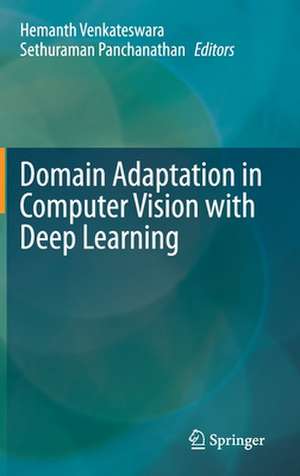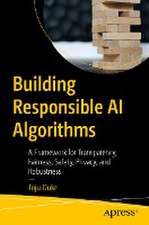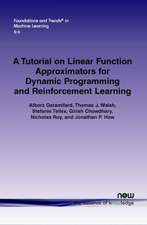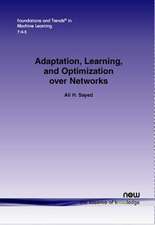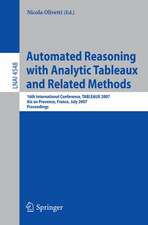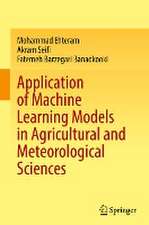Domain Adaptation in Computer Vision with Deep Learning
Editat de Hemanth Venkateswara, Sethuraman Panchanathanen Limba Engleză Hardback – 19 aug 2020
Divided into four parts, the first part of this book begins with an introduction to domain adaptation, which outlines the problem statement, the role of domain adaptation and the motivation for research in this area. It includes a chapter outlining pre-deep learning era domain adaptation techniques. The second part of this book highlights feature alignment based approaches to domain adaptation. The third part of this book outlines image alignment procedures for domain adaptation. The final section of this book presents novel directions for research in domain adaptation.
This book targets researchers working in artificial intelligence, machine learning, deep learning and computer vision. Industry professionals and entrepreneurs seeking to adopt deep learning into their applications will also be interested in this book.
| Toate formatele și edițiile | Preț | Express |
|---|---|---|
| Paperback (1) | 985.68 lei 6-8 săpt. | |
| Springer International Publishing – 19 aug 2021 | 985.68 lei 6-8 săpt. | |
| Hardback (1) | 991.94 lei 6-8 săpt. | |
| Springer International Publishing – 19 aug 2020 | 991.94 lei 6-8 săpt. |
Preț: 991.94 lei
Preț vechi: 1239.91 lei
-20% Nou
Puncte Express: 1488
Preț estimativ în valută:
189.83€ • 206.13$ • 159.46£
189.83€ • 206.13$ • 159.46£
Carte tipărită la comandă
Livrare economică 22 aprilie-06 mai
Preluare comenzi: 021 569.72.76
Specificații
ISBN-13: 9783030455286
ISBN-10: 3030455289
Ilustrații: XI, 256 p. 76 illus., 55 illus. in color.
Dimensiuni: 155 x 235 mm
Greutate: 0.55 kg
Ediția:1st ed. 2020
Editura: Springer International Publishing
Colecția Springer
Locul publicării:Cham, Switzerland
ISBN-10: 3030455289
Ilustrații: XI, 256 p. 76 illus., 55 illus. in color.
Dimensiuni: 155 x 235 mm
Greutate: 0.55 kg
Ediția:1st ed. 2020
Editura: Springer International Publishing
Colecția Springer
Locul publicării:Cham, Switzerland
Cuprins
Preface.- Part I: Introduction.- Chapter 1: Introduction to Domain Adaptation.- Chapter 2: Shallow Domain Adaptation.- Part II: Domain Alignment in the Feature Space.- Chapter 3: d-SNE: Domain Adaptation using Stochastic Neighborhood Embedding.- Chapter 4: Deep Hashing Network for Unsupervised Domain Adaptation.- Chapter 5: Re-weighted Adversarial Adaptation Network for Unsupervised Domain Adaptation.- Part III: Domain Alignment in the Image Space.- Chapter 6: Unsupervised Domain Adaptation with Duplex Generative Adversarial Network.- Chapter 7: Domain Adaptation via Image to Image Translation.- Chapter 8: Domain Adaptation via Image Style Transfer.- Part IV: Future Directions in Domain Adaptation.- Chapter 9: Towards Scalable Image Classifier Learning with Noisy Labels via Domain Adaptation.- Chapter 10: Adversarial Learning Approach for Open Set Domain Adaptation.- Chapter 11: UniversalDomain Adaptation.- Chapter 12: Multi-source Domain Adaptation by Deep CockTail Networks.- Chapter 13: Zero-Shot Task Transfer.
Notă biografică
Hemanth Venkateswara is an Assistant Research Professor at the School of Computing Informatics and Decision Systems Engineering at Arizona State University. He completed his PhD in machine learning and computer vision in 2017 from Arizona State University. Hemanth’s research interests include transfer learning, active learning, zero-shot learning, incremental learning and generative models using deep learning. His research explores knowledge transfer paradigms for deep neural networks that are challenging to train due to paucity of annotated data. Hemanth holds a bachelor’s degree in Physics and master’s degrees in Physics and Computer Science. Prior to his PhD, Hemanth worked as a senior software engineer at Alcatel-Lucent Technologies, India. Hemanth is a member of the IEEE and the ACM.
Sethuraman “Panch” Panchanathan leads the knowledge enterprise at Arizona State University, which advances research, innovation, strategic partnerships, entrepreneurship,global and economic development at ASU. He is the Director of the Center for Cognitive Ubiquitous Computing at ASU. Panchanathan’s research interests are in the areas of human-centered multimedia computing, haptic user interfaces, person-centered tools and ubiquitous computing technologies for enhancing the quality of life for individuals with disabilities, machine learning for multimedia applications, medical image processing, and media processor designs. Panchanathan has published more than 500 papers in refereed journals and conferences and has mentored nearly 150 graduate students, post-docs, research engineers and research scientists who occupy leading positions in academia and industry. He was the editor-in-chief of the IEEE Multimedia Magazine and is also an editor/associate editor of several international journals and transactions. Panchanathan was appointed by President Barack Obama to the U.S. National Science Board for a six-year term and was appointed by the U.S. Secretaryof Commerce to the National Advisory Council on Innovation and Entrepreneurship. In Dec 2019, Panchanathan was nominated as the Director for the National Science Foundation by President Donald Trump. Panchanathan is a fellow and Vice President for Strategic Initiatives and Membership of the National Academy of Inventors. In 2018, Panchanathan was appointed Arizona Governor Doug Ducey’s Senior Advisor for Science & Technology. Panchanathan is a Fellow of the NAI, American Association for the Advancement of Science (AAAS), the Canadian Academy of Engineering (CAE), the Institute of Electrical and Electronics Engineers (IEEE) and the Society of Optical Engineering (SPIE).
Textul de pe ultima copertă
This book provides a survey of deep learning approaches to domain adaptation in computer vision. It gives the reader an overview of the state-of-the-art research in deep learning based domain adaptation. This book also discusses the various approaches to deep learning based domain adaptation in recent years. It outlines the importance of domain adaptation for the advancement of computer vision, consolidates the research in the area and provides the reader with promising directions for future research in domain adaptation.
Divided into four parts, the first part of this book begins with an introduction to domain adaptation, which outlines the problem statement, the role of domain adaptation and the motivation for research in this area. It includes a chapter outlining pre-deep learning era domain adaptation techniques. The second part of this book highlights feature alignment based approaches to domain adaptation. The third part of this book outlines image alignment procedures for domain adaptation. The final section of this book presents novel directions for research in domain adaptation.
This book targets researchers working in artificial intelligence, machine learning, deep learning and computer vision. Industry professionals and entrepreneurs seeking to adopt deep learning into their applications will also be interested in this book.
Divided into four parts, the first part of this book begins with an introduction to domain adaptation, which outlines the problem statement, the role of domain adaptation and the motivation for research in this area. It includes a chapter outlining pre-deep learning era domain adaptation techniques. The second part of this book highlights feature alignment based approaches to domain adaptation. The third part of this book outlines image alignment procedures for domain adaptation. The final section of this book presents novel directions for research in domain adaptation.
This book targets researchers working in artificial intelligence, machine learning, deep learning and computer vision. Industry professionals and entrepreneurs seeking to adopt deep learning into their applications will also be interested in this book.
Caracteristici
A one-stop-shop for domain adaptation research that highlights the various approaches to domain adaptation Revisits the problem statement and assumptions in domain adaptation Proposes promising directions for future research in this area that allows domain adaptation applicable to real-world problems
